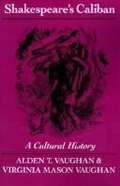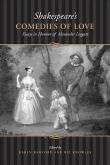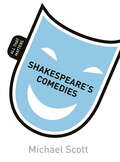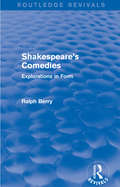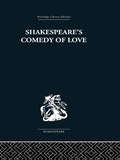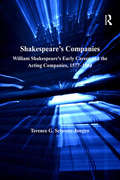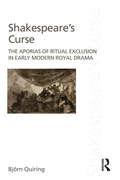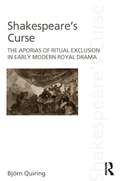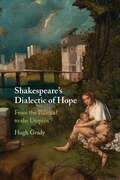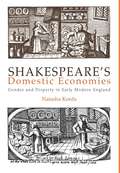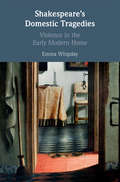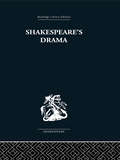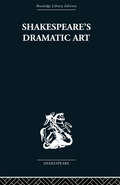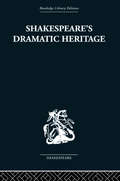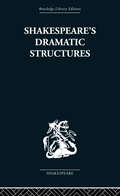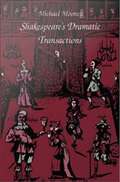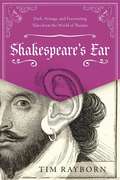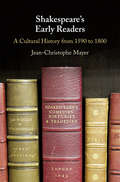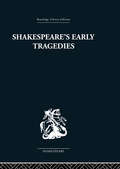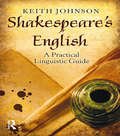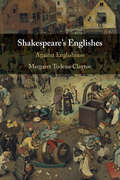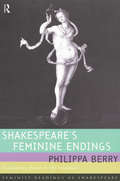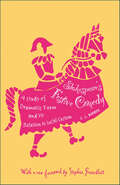- Table View
- List View
Shakespeare's Caliban: A Cultural History
by Alden T. Vaughan; Virginia Mason VaughanShakespeare's Caliban examines The Tempest's "savage and deformed slave" as a fascinating but ambiguous literary creation with a remarkably diverse history. The authors, one a historian and the other a Shakespearean, explore the cultural background of Caliban's creation in 1611 and his disparate metamorphoses to the present time.
Shakespeare's Comedies of Love
by Karen BamfordBorrowing its title from renowned scholar Alexander Leggatt's landmark 1974 study, Shakespeare's Comedies of Love is a tribute to a critic who has shaped the way the world understands Shakespeare and his comedies. To help celebrate his distinguished career as a teacher and scholar, this collection of essays presents a wide range of new work on the Bard's comedies. The contributors cover diverse areas of inquiry, including the use of the comedies as a source of women's empowerment in nineteenth-century America; civic drama in Elizabethan London; male anxiety about women in the comedies; anti-Semitism in The Merchant of Venice; as well as some key productions of Shakespeare's comedies. Rich in detail and broad in scope, Shakespeare's Comedies of Love is a celebration of Leggatt's distinguished career, and an enduring collection of work on the world's most famous writer.
Shakespeare's Comedies: All That Matters (All That Matters)
by Michael ScottIn Shakespeare's Comedies: All That Matters, Mike Scott explores and explains the secrets that have made Shakespeare's comedies so enduring that they continue to be performed, watched and studied by millions of people every year. Professor Scott focuses in turn on The Comedy of Errors, A Midsummer Night's Dream, Twelfth Night, As You Like It and The Merchant of Venice and builds an argument based around Shakepeare's use of language to prompt the audience's imagination and thought. This original little book, and its companion volume Shakespeare's Tragedies, fills a major gap in the market for a book which will enable readers to understand a Shakesperean play in the context of its ouevre.This accessible and readable book will appeal both to students and general readers, giving a fascinating intoruduction to Shakespeare's comedies - and what matters most about them."'Comedy is a serious business' says Michael Scott - it is, and his splendid short book takes it very seriously as it should, but remains lively and wonderfully readable withall." Dr Drummond Bone, Master of Balliol College, Oxford"An authoritative and expert overview of the entire fields of Shakespearean Comedy and Tragedy combined with persuasive and eminently accessible close readings of particular plays. Michael Scott brings to the task and infectious enthusiasm and deep knowledge of their theatrical, literary and cultural significance and he provides a clear and compelling endorsement of their continued relevance. These books provide an exemplary introduction to the complex world of Shakespearean drama, full of insights, observations, and ideas, all of which are brought firmly to bear on the abiding question of what these plays mean for us today." John Drakakis, Professor of English at the University of Stirling"Everything is so clear - no academic jargon, for instance. With Shakespeare's Comedies, even the most critical scholars can learn something... as well as students at the start of their encounter with Shakespeare and the same for regular theatre goers. To address all three at once... has to be an accomplishment... from the Introduction to the Conclusion... to the last sentence: (the) reader will readily grasp why this series of books is called All That Matters." Professor M.L.Wine, Evanston, USA
Shakespeare's Comedies: All That Matters (Atm Ser.)
by Mike ScottIn Shakespeare's Comedies: All That Matters, Mike Scott explores and explains the secrets that have made Shakespeare's comedies so enduring that they continue to be performed, watched and studied by millions of people every year. Professor Scott focuses in turn on he Comedy of Errors, A Midsummer Night's Dream, Twelfth Night, As You Like It and The Merchant of Venice and builds an argument based around Shakepeare's use of language to prompt the audience's imagination and thought. This original little book, and its companion volume Shakespeare's Tragedies, fills a major gap in the market for a book which will enable readers to understand a Shakesperean play in the context of its ouevre. This accessible and readable book will appeal both to students and general readers, giving a fascinating intoruduction to Shakespeare's comedies - and what matters most about them.
Shakespeare's Comedies: Explorations in Form (Routledge Revivals)
by Ralph BerryIn this lucid and original study, first published in 1972, Ralph Berry discusses the ten comedies that run from The Comedy of Errors to Twelfth Night. Berry’s purpose is to identify the form of each play by relating the governing idea of the play to the action that expresses it. To this end the author employs a variety of standpoints and techniques, and taken together, these chapters present a lively and coherent view of Shakespeare’s techniques, concerns, and development. This title will be of interests to students of literature and drama.
Shakespeare's Comedy of Love
by Alexander LeggattFirst published in 1987. This study removes some of the critical puzzles that Shakespeare's comedies of love have posed in the past. The author shows that what distinguishes the comedies is not their similarity but their variety - the way in which each play is a new combination of essentially similar ingredients, so that, for example, the boy/girl changes in The Merchant of Venice are seen to have a quite different significance from those in As You Like It.
Shakespeare's Companies: William Shakespeare's Early Career and the Acting Companies, 1577–1594 (Studies In Performance And Early Modern Drama Ser.)
by Terence G. Schoone-JongenFocusing on a period (c.1577-1594) that is often neglected in Elizabethan theater histories, this study considers Shakespeare's involvement with the various London acting companies before his membership in the Lord Chamberlain's Men in 1594. Locating Shakespeare in the confusing records of the early London theater scene has long been one of the many unresolved problems in Shakespeare studies and is a key issue in theatre history, Shakespeare biography, and historiography. The aim in this book is to explain, analyze, and assess the competing claims about Shakespeare's pre-1594 acting company affiliations. Schoone-Jongen does not demonstrate that one particular claim is correct but provides a possible framework for Shakespeare's activities in the 1570s and 1580s, an overview of both London and provincial playing, and then offers a detailed analysis of the historical plausibility and probability of the warring claims made by biographers, ranging from the earliest sixteenth-century references to contemporary arguments. Full chapters are devoted to four specific acting companies, their activities, and a summary and critique of the arguments for Shakespeare's involvement in them (The Queen's Men, Strange's Men, Pembroke's Men, and Sussex's Men), a further chapter is dedicated to the proposition Shakespeare's first theatrical involvement was in a recusant Lancashire household, and a final chapter focuses on arguments for Shakespeare's membership in a half dozen other companies (most prominently Leicester's Men). Shakespeare's Companies simultaneously opens up twenty years of theatrical activity to inquiry and investigation while providing a critique of Shakespearean biographers and their historical methodologies.
Shakespeare's Curse
by Bjoern QuiringConceptualizing the curse as the representation of a foundational, mythical violence that is embedded within juridical discourse, Shakespeare’s Curse pursues a reading of Richard III, King John, and King Lear in order to analyse the persistence of imprecations in the discourses of modernity. Shakespeare wrote during a period that was transformative in the development of juridical thinking. However, taking up the relationship between theatre, theology and law, Bjoern Quiring argues that the curse was not eliminated from legal discourses during this modernization of jurisprudence; rather, it persisted and to this day continues to haunt numerous speech acts. Drawing on the work of Derrida, Lacan, Walter Benjamin and Giorgio Agamben, among others, Quiring analyses the performativity of the curse, and tracks its power through the juristic themes that are pursued within Shakespeare’s plays – such as sovereignty, legitimacy, succession, obligation, exception, and natural law. Thus, this book provides an original and important insight into early modern legal developments, as well as a fresh perspective on some of Shakespeare’s best-known works. A fascinating interdisciplinary study, this book will interest students and scholars of Law, Literature, and History.
Shakespeare's Curse: The Aporias of Ritual Exclusion in Early Modern Royal Drama
by Björn QuiringConceptualizing the curse as the representation of a foundational, mythical violence that is embedded within juridical discourse, Shakespeare’s Curse:The Aporias of Ritual Exclusion in Early Modern Royal Drama pursues a reading of Richard III, King John, and King Lear in order to analyse the persistence of imprecations in the discourses of modernity. Shakespeare wrote during a period that was transformative in the development of juridical thinking. However, taking up the relationship between theater, theology and law, Björn Quiring argues that the curse was not eliminated from legal discourses during this modernization of jurisprudence; rather, it persisted and to this day continues to haunt numerous speech acts. Drawing on the work of Derrida, Lacan, Walter Benjamin and Giorgio Agamben, among others, Quiring analyses the performativity of the curse, and tracks its power through the juristic themes that are pursued within Shakespeare’s plays – such as sovereignty, legitimacy, succession, obligation, exception, and natural law. Thus, this book provides an original and important insight into early modern legal developments, as well as a fresh perspective on some of Shakespeare’s best known works. A fascinating interdisciplinary study, this book will interest students and scholars of Law, Literature, and History.
Shakespeare's Dialectic of Hope: From the Political to the Utopian
by Hugh GradyClosely examining the relationship between the political and the utopian in five major plays from different phases of Shakespeare's career, Hugh Grady shows the dialectical link between the earlier political dramas and the late plays or tragicomedies. Reading Julius Caesar and Macbeth from the tragic period alongside The Winter's Tale and Tempest from the utopian end of Shakespeare's career, with Antony and Cleopatra acting as a transition, Grady reveals how, in the late plays, Shakespeare introduces a transformative element of hope while never losing a sharp awareness of suffering and death. The plays presciently confront dilemmas of an emerging modernity, diagnosing and indicting instrumental politics and capitalism as largely disastrous developments leading to an empty world devoid of meaning and community. Grady persuasively argues that the utopian vision is a specific dialectical response to these fears and a necessity in worlds of injustice, madness and death.
Shakespeare's Domestic Economies: Gender and Property in Early Modern England
by Natasha KordaShakespeare's Domestic Economies explores representations of female subjectivity in Shakespearean drama from a refreshingly new perspective, situating The Taming of the Shrew, The Merry Wives of Windsor, Othello, and Measure for Measure in relation to early modern England's nascent consumer culture and competing conceptions of property. Drawing evidence from legal documents, economic treatises, domestic manuals, marriage sermons, household inventories, and wills to explore the realities and dramatic representations of women's domestic roles, Natasha Korda departs from traditional accounts of the commodification of women, which maintain that throughout history women have been "trafficked" as passive objects of exchange between men.In the early modern period, Korda demonstrates, as newly available market goods began to infiltrate households at every level of society, women emerged as never before as the "keepers" of household properties. With the rise of consumer culture, she contends, the housewife's managerial function assumed a new form, becoming increasingly centered around caring for the objects of everyday life—objects she was charged with keeping as if they were her own, in spite of the legal strictures governing women's property rights. Korda deftly shows how their positions in a complex and changing social formation allowed women to exert considerable control within the household domain, and in some areas to thwart the rule of fathers and husbands.
Shakespeare's Domestic Tragedies: Violence in the Early Modern Home
by Emma WhipdayDomestic tragedy was an innovative genre, suggesting that the lives and sufferings of ordinary people were worthy of the dramatic scope of tragedy. In this compelling study, Whipday revises the narrative of Shakespeare's plays to show how this genre, together with neglected pamphlets, ballads, and other forms of 'cheap print' about domestic violence, informed some of Shakespeare's greatest works. Providing a significant reappraisal of Hamlet, Othello, and Macbeth, the book argues that domesticity is central to these plays: they stage how societal and familial pressures shape individual agency; how the integrity of the house is associated with the body of the housewife; and how household transgressions render the home permeable. Whipday demonstrates that Shakespeare not only appropriated constructions of the domestic from domestic tragedies, but that he transformed the genre, using heightened language, foreign settings, and elite spheres to stage familiar domestic worlds.
Shakespeare's Drama
by Una Ellis-FermorFirst published in 1980. This collection of essays by the first General Editor of the New Arden Shakespeare brings together the best of Ellis-Fermor's Shespearean criticism, in addition to outstanding essays on Coriolanus and Troilus and Cressida. Collected and edited by Kenneth Muir, the book is prefaced by an appreciation of Ellis-Fermor's work.
Shakespeare's Dramatic Art: Collected Essays
by Wolfgang ClemenFirst published in 1972. Studying Shakespeare's 'art of preparation', this book illustrates the relationship between the techniques of preparation and the structure and theme of the plays. Other essays cover Shakespeare's use of the messenger's report, his handling of the theme of appearance and reality and the basic characteristics of Shakespearian drama.
Shakespeare's Dramatic Heritage: Collected Studies in Mediaeval, Tudor and Shakespearean Drama
by Glynne WickhamShakespeare's Dramatic Heritage shows that the drama of Elizabethan and Jacobean England is deeply indebted to the religious drama of the Middle Ages and represents a climax, in secular guise, to mediaeval experiment and achievement rather than a new beginning. This is fully examined in terms of dramatic literature as well as in terms of theatres, stages and production conventions. The plays studied include: Richard II, A Midsummer Night's Dream, Hamlet, Macbeth, Coriolanus, The Winter's Tale and Marlowe's King Edward II.
Shakespeare's Dramatic Structures
by Anthony BrennanFirst published in 1986. The focus of this book is the dramatic strategies of scenic repetition and character separation. The author traces the way in which Shakesperare often presents recurring gestures, dramatic interactions, and complex scenic structures at widely separated intervals in a play - thereby providing an internal system of cross-reference for an audience. He also examines the way in which Shakespeare increases the dramatic voltage in central relationships by limiting the access key characters have to each other on stage. These strategies, it is argued, are indelible marks of Shakespeare's craftsmanship which survive all attempts to obliterate it in many modern productions.
Shakespeare's Dramatic Transactions
by Michael E. MooneyShakespeare's Dramatic Transactions uses conventions of performance criticism--staging and theatrical presentation--to analyze seven major Shakespearean tragedies: Hamlet, Othello, King Lear, Macbeth, Antony and Cleopatra, Richard II, and Richard III. As scholars and readers increasingly question the theoretical models used to describe the concepts of "mimesis" and "representation," this book describes how the actor's stage presentation affects the actor's representational role and the ways in which viewers experience Shakespearean tragedy. Michael Mooney draws on the work of East German critic Robert Weimann and his concept of figurenposition--the correlation between an actor's stage location and the speech, action, and stylization associated with that position--to understand the actor/stage location relationship in Shakespeare's plays. In his examination of the original staging of Shakespeare's tragedies, Mooney looks at the traditional interplay between a downstage "place" and upstage "location" to describe the difference between non-illusionistic action (often staged near the audience) and the illusionistic, localized action that characterizes mimetic art. The innovative and insightful approach of Shakespeare's Dramatic Transactions brings together the techniques of performance criticism and the traditional literary study of Shakespearean tragedy. In showing how the distinctions of stage location illuminate the interaction among language, representation, Mooney's compelling argument enhances our understanding of Shakespeare and the theater.
Shakespeare's Ear: Dark, Strange, and Fascinating Tales from the World of Theater
by Tim RaybornShakespeare’s Ear presents dark and sometimes funny pieces of fact and folklore that bedevil the mostly unknown history of theater. All manner of skullduggery, from revenge to murder, from affairs to persecution, proves that the drama off-stage was just as intense as any portrayed on it. The stories include those of: An ancient Greek writer of tragedies who dies when an eagle drops a tortoise on his head. A sixteenth-century English playwright who lives a double life as a spy and perishes horribly, stabbed above the eye. A small Parisian theater where grisly horrors unfold on stage. The gold earring that Shakespeare wears in the Chandos portrait, and its connections to bohemians and pirates of the time. Journey back to see theatrical shenanigans from the ancient Near East, explore the violent plays of ancient Greece and Rome, revel in the Elizabethan and Jacobean golden age of blood-thirsty drama, delight in the zany and subversive antics of the Commedia dell’arte, and tremble at ghostly incursions into playhouses. Here you will find many fine examples of playwrights, actors, and audiences alike being horrible to each other over the centuries.
Shakespeare's Early Readers: A Cultural History from 1590 to 1800
by Jean-Christophe MayerWho were Shakespeare's first readers and what did they think of his works? Offering the first dedicated account of the ways in which Shakespeare's texts were read in the centuries during which they were originally produced, Jean-Christophe Mayer reconsiders the role of readers in the history of Shakespeare's rise to fame and in the history of canon formation. Addressing an essential formative 'moment' when Shakespeare became a literary dramatist, this book explores six crucial fields: literacy; reading and life-writing; editing Shakespeare's text; marking Shakespeare for the theatre; commonplacing; and passing judgement. Through close examination of rare material, some of which has never been published before, and covering both the marks left by readers in their books and early manuscript extracts of Shakespeare, Mayer demonstrates how the worlds of print and performance overlapped at a time when Shakespeare offered a communal text, the ownership of which was essentially undecided.
Shakespeare's Early Tragedies
by Nicholas BrookeFirst published in 1968. Shakespeare's Early Tragedies contains studies of six plays: Titus Andronicus, Richard III, Romeo and Juliet, Richard II, Julius Caesar and Hamlet. The emphasis is on the variety of the plays, and the themes, a variety which has been too often obscured by the belief in a single 'tragic experience'. The kind of experience the plays create and their quality as dramatic works for the stage are also examined. These essays develop an understanding of Shakespeare's use of the stage picture in relation to the emblematic imagery of Elizabethan poetry.
Shakespeare's English: A Practical Linguistic Guide
by Keith JohnsonShakespeare's English: A Practical Linguistic Guide provides students with a solid grounding for understanding the language of Shakespeare and its place within the development of English. With a prime focus on Shakespeare and his works, Keith Johnson covers all aspects of his language (vocabulary, grammar, sounds, rhetorical structure etc.), and gives illuminating background information on the linguistic context of the Elizabethan Age. As well as providing a unique introduction to the subject, Johnson encourages a "hands-on" approach, guiding students, through the use of activities, towards an understanding of how Shakespeare's English works. This book offers: · A unique approach to the study of Early Modern English which enables students to engage independently with the topic · Clear and engagingly written explanations of linguistic concepts · Plentiful examples and activities, including suggestions for further work · A glossary, further reading suggestions and guidance to relevant websites Shakespeare's English is perfect for undergraduate students following courses that combine English language, linguistics and literature, or anyone with an interest in knowing more about the language with which Shakespeare worked his literary magic.
Shakespeare's Englishes: Against Englishness
by Margaret Tudeau-ClaytonWhose English is 'true' English? What is its relation to the national character? These were urgent questions in Shakespeare's England just as questions of language and identity are today. Through close readings of early comedies and history plays, this study demonstrates how Shakespeare resists the shaping of ideas of the English language and national character by Protestant Reformation ideology. Tudeau-Clayton argues this ideology promoted the notional temperate and honest citizen, plainly spoken and plainly dressed, as the normative centre of (the) 'true' English. Compelling studies of two symmetrical pairs of cultural memes: 'the King's English' versus 'the gallimaufry' and 'the true-born Englishman' versus the 'Fantastical Gull', that demonstrate how 'the traitor' came to be defined as much by non-conformity to cultural 'habits' as by allegiance to the monarch. Tudeau-Clayton cogently argues Shakespeare subverted this narrow, class-inflected concept of English identity, proposing instead an inclusive, mixed and unlimited community of 'our English'.
Shakespeare's Erotic Mythology and Ovidian Renaissance Culture
by Agnès LafontTaking cross-disciplinary and comparative approaches to the volume’s subject, this exciting collection of essays offers a reassessment of Shakespeare’s erotic and Ovidian mythology within classical and continental aesthetic contexts. Through extensive examination of mythological visual and textual material, scholars explore the transmission and reinvention of Ovidian eroticism in Shakespeare’s plays to show how early modern artists and audiences collectively engaged in redefining ways of thinking pleasure. Within the collection’s broad-ranging investigation of erotic mythology in Renaissance culture, each chapter analyses specific instances of textual and pictorial transmission, reception, and adaptation. Through various critical strategies, contributors trace Shakespeare’s use of erotic material to map out the politics and aesthetics of pleasure, unravelling the ways in which mythology informs artistic creation. Received acceptions of neo-platonic love and the Petrarchan tensions of unattainable love are revisited, with a focus on parodic and darker strains of erotic desire, such as Priapic and Dionysian energies, lustful fantasy and violent eros. The dynamics of interacting tales is explored through their structural ability to adapt to the stage. Myth in Renaissance culture ultimately emerges not merely as near-inexhaustible source material for the Elizabethan and Jacobean arts, but as a creative process in and of itself.
Shakespeare's Feminine Endings: Disfiguring Death in the Tragedies (Feminist Readings of Shakespeare)
by Philippa BerryPhilippa Berry draws on feminist theory, postmodern thought and queer theory, to challenge existing critical notions of what is fundamental to Shakespearean tragedy. She shows how, through a network of images clustered around feminine or feminized characters, these plays 'disfigure' conventional ideas of death as a bodily end, as their figures of women are interwoven with provocative meditations upon matter, time, the soul, and the body. The scope of these tragic speculations was radical in Shakespeare's day; yet they also have a surprising relevance to contemporary debates about time and matter in science and philosophy.
Shakespeare's Festive Comedy: A Study of Dramatic Form and Its Relation to Social Custom
by C. L. BarberIn this classic work, acclaimed Shakespeare critic C. L. Barber argues that Elizabethan seasonal festivals such as May Day and Twelfth Night are the key to understanding Shakespeare's comedies. Brilliantly interweaving anthropology, social history, and literary criticism, Barber traces the inward journey--psychological, bodily, spiritual--of the comedies: from confusion, raucous laughter, aching desire, and aggression, to harmony. Revealing the interplay between social custom and dramatic form, the book shows how the Elizabethan antithesis between everyday and holiday comes to life in the comedies' combination of seriousness and levity. "I have been led into an exploration of the way the social form of Elizabethan holidays contributed to the dramatic form of festive comedy. To relate this drama to holiday has proved to be the most effective way to describe its character. And this historical interplay between social and artistic form has an interest of its own: we can see here, with more clarity of outline and detail than is usually possible, how art develops underlying configurations in the social life of a culture."--C. L. Barber, in the Introduction This new edition includes a foreword by Stephen Greenblatt, who discusses Barber's influence on later scholars and the recent critical disagreements that Barber has inspired, showing that Shakespeare's Festive Comedy is as vital today as when it was originally published.
